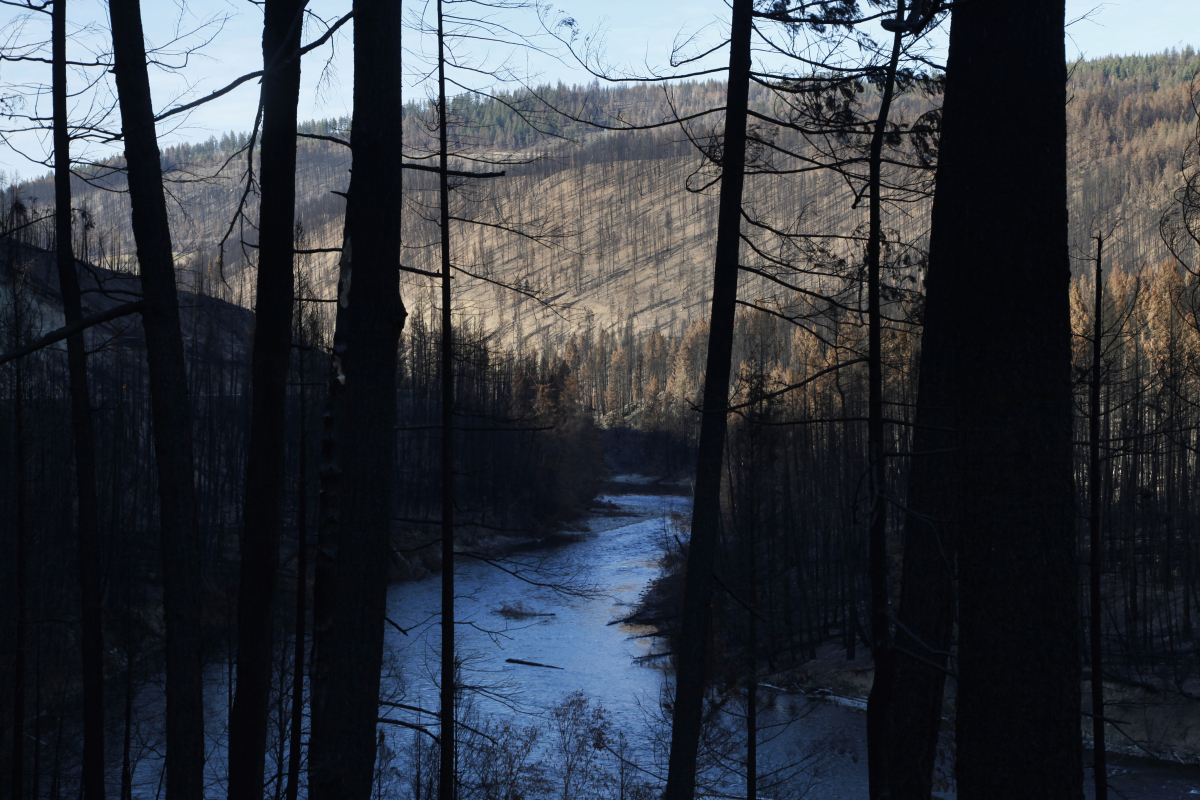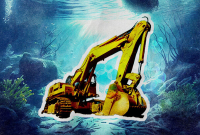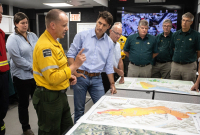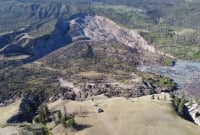Support strong Canadian climate journalism for 2025
Years ago, ecologist Dr. Karen Price walked through a forest ravaged by wildfire that had been logged and replanted. It was a uniform mass of pine trees, devoid of birds and wildlife — it was “ecologically boring,” she recalls.
By contrast, the nearby eco reserve — which had also burned, but was left undisturbed — was a sound bath of bird calls and rustling leaves, and home to rare wildlife like goshawks. She notes that while this is just an anecdote, the juxtaposition was a more powerful illustration of the difference between a forest logged for “salvage lumber” and one left to regrow naturally than she’d seen in any graphs of young forests.
Price, alongside other experts, is expressing concern that salvage logging — the process of logging wildfire-disturbed forests — has no ecological benefit and contradicts B.C.’s promise to prioritize ecosystem health over timber. They say, in that context, the process should be reconsidered.
However, the B.C. government released new regulations in April that expedite the practice.
The 2023 wildfires were the most destructive in B.C.’s history, and burned out more than 2.8 million hectares of forest. In April, the provincial government introduced new measures that make logging wildfire-damaged timber easier and “more economic” for forestry operations and First Nations, according to a press release accompanying the change.
The release explains that “salvage allows for quicker reforestation efforts and land recovery after wildfires,” and the new measures streamline the process to allow for these outcomes.
In a panel facilitated by Conservation North, an environmental group, many experts agreed that salvage logging is carried out to compensate for lost timber profits post-fire, but reforestation and land recovery actually occur more productively without such interference.
“We always think we have to do something, that we have to fix something,” Price told Canada’s National Observer. “Often, the best action to restore an ecosystem is to let it restore itself. Nature does better than humans.”
The Draft B.C. Biodiversity and Ecosystem Health Framework, introduced in 2023, describes a vision for resource management that focuses on protecting biodiversity and ecosystem health.
“We've come from a long history of industrialized forestry,” says Lennard Joe, CEO of the BC First Nations Forestry Council, as well as a registered professional forester and member of the Nlaka’pamux First Nation. “Now we're being faced with changes in climate, and it's extreme. We've got to find ways to move forward.”
The Old Growth Strategic Review, another effort to reevaluate the province’s natural resource priorities and old growth management, acknowledges that “society is undergoing a paradigm shift in its relationship with the environment, and the way we manage our old forests needs to adapt accordingly.”
Price says the move to streamline salvage logging is “very concerning, because it goes against any potential ‘paradigm shift.’”
Eddie Petryshen, a conservation specialist with environmental advocacy group Wildsight, says the continued practice of salvage logging hinges on a misunderstanding. Also sometimes called harvest or sanitation logging — and said to promote “renewal” and “recovery” — the implication is that the practice fosters a healthier, more resilient ecosystem, he says.
“We're acting like that's a really good thing to be happening on the landscape and that we need to streamline it to make it easier to incentivize it,” he says. “This is what some of the world's best forest ecologists call ‘attacks on natural ecological recovery.’”
Price agrees. “Logging is logging,” she says. “You're removing trees from an ecosystem. And in that perspective, it doesn't matter if you're removing it from a live forest or dead forest.”
Price explains that actually, dead trees often have as much or more ecological value as live trees. They continue to store carbon, benefit species that rely on dead or burnt wood and create a biodiverse environment.
Areas where salvage logging and replanting occurs often become “biological deserts,” she says, removing natural complexity that is essential for the wellbeing of forests. Disturbed trees, fallen logs, and snags (dead trees left upright to degrade) all contribute to a healthier ecosystem than those that develop after salvage and replanting.
The ministry argued in a statement that salvage logging makes forests more resilient against wildfire.
“By salvaging dead and dying trees, we are reducing fuel and the risk of future wildfires,” the ministry said in a statement. Experts outside the government disagree, saying salvage and replanting can actually increase that fuel, as well as the severity of future burns. On the other hand, burned forests left alone can resist wildfire for at least 20 years.
A 2021 study from Forest Ecology and Management concludes that "salvage logging does not necessarily prevent subsequent disturbances, and sometimes it may increase disturbance likelihood and magnitude.”
For Price, a wealth of factors — the primary values of the specific ecosystem in question, what kinds of trees are being harvested and fire severity — need to be considered for salvage to take place in a way that honours a shift away from timber-centric values.
But Petryshen explains that the province incentivizes salvage by reducing fees for logging burned wood and making regular adjustments to the amount of timber logging companies are allowed to log each year on the basis of how much burned wood is available to salvage — such as the changes made in April.
Since natural resources are managed provincially, salvage logging regulations vary province to province in Canada. In general, salvage logging is noted in different provinces’ forest legislation as an option following wildfire or other natural disturbances. Many provinces, including B.C., provide incentives for salvage, like reduced fees for harvesting, or adjusting a predetermined harvest volume to allow for salvage. In Alberta, Manitoba, Ontario and Quebec, the amount of harvest allowed per year can also be adjusted to account for the salvage of wildfire-burned areas.
Salvage logging is an economically important practice across the country. In B.C., companies and First Nations rely on salvage logging to compensate for timber lost to wildfires.
Joe, with the First Nations Forestry Council, notes that for the majority of First Nations reserves in rural areas in B.C., forestry is a primary economic business.
“Salvage is a part of the process,” he says. “There’s a number of things you have to balance when you look at it. … You can’t just do a simple brushstroke.”
The Ministry of Forests said in its statement that values such as “retention, watershed health, water quality, wildlife habitat, biodiversity, burn severity, hydrological systems, soil productivity, cultural values and reforestation” must be considered when salvage logging.
For Price, the solution isn’t to do away with salvage logging altogether, it’s to reconsider the approach from a perspective that’s “ecologically based, so it puts ecological values at the forefront, adding timber as a service that the ecosystem provides for humans.”
“We are living amidst biodiversity and climate crises,” she adds. “Every decision we make should be in that context.”






Comments
The author appears to have not noticed that there are two conversations going on: one about apples; one about oranges.
The two words that create the dichotomy are "and replanted".
We are informed about two possible paths forward: salvage-logged and replanted; and left alone to naturally regenerate. We are, however, left bereft of understanding what might occur with a natural regeneration of a burn if it has been salvage-logged.
For example, did the birdsong return to the naturally regenerated patch because the charred trunks were left standing, or because the ground was left undisturbed (and untreated with pedticides?) to be recolonized by pioneer flora species that enticed fauna to return?
I.e. are we talking about regenerating a forest or a tree plantation?